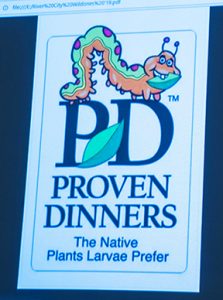FEBRUARY 18, 2019 PROGRAM RECAP
—by Ruth Oldenburg
Trends in Native Plant Production: Reflections on the past, present and future use of native plants in the landscape
Presented by Bill Schneider, owner, Wildtype Native Plant Nursery
 The Wild Ones River City Chapter members and guests were treated to a very interesting presentation by Bill Schneider of Wildtype Native Plant Nursery near Mason, Michigan.
The Wild Ones River City Chapter members and guests were treated to a very interesting presentation by Bill Schneider of Wildtype Native Plant Nursery near Mason, Michigan.
Wildtype has grown plants native to Michigan since 1996. The plants are specifically from Michigan genotypes. They grow forbs, grasses, trees, shrubs. Wildtype’s objective is to propagate nursery stock with enough genetic diversity to create self-sustaining populations. They accomplish this by primarily using wild seed stock so it has not been intentionally selected for uniformity.
Primarily a wholesale business, Wildtype is open to the public 12 days per year for retail sales. Check their website for retail sales dates and retail catalogue.
Wildtype also provides contracting, design consulting, and environmental landscaping for public, commercial and residential projects.
Schneider spoke about restoration horticulture—where population genetics meets horticulture. Homogeneity (uniformity) is the goal in horticulture. Heterogeneity (diversity) is the goal in restoration horticulture.
The Past —
Bill showed a slide of a pre-European settlement vegetation map of Michigan which is still an important historical reference. Since the landscape is changing so quickly and invasive species have overrun many areas, it is not as valuable as a restoration reference.
The Present —
Native plant trends now:
- greater availability
- slowly changing aesthetic
- differences between gardening and naturalization
- differences between agriculture and conservation
- greater demand
Landscapes now:
- Traditional landscape
- Native landscape
- Re-created landscape
- Restoring native landscape remnants
Other trends:
- Species loss
- Changing climate and environment
- More invasive species
(The combination of the above has shrunken the “ambient” gene pool.)
Schneider said that 70% of his sales are for only 30% of native species. Some plants are just too difficult to grow such as Trout Lily and Dutchman’s Breeches. Woody plants are not easy to grow. He has collected seeds of native species from 54 counties.
The Future—
Climate models indicate that Michigan’s climate may become more like Oklahoma and the Ozarks. Climate IS changing, however, the physical geography of our region will not change. Michigan’s topography, soils, and latitudinal differences in day length will remain the same. But the variability contained within species will likely contain genes that will help them adapt to future changes that occur over time.
Take-away—
Opportunities abound for native plant production as people become more educated about natives and the demand for more native plants continues to grow.


